Double Craters
-
 by
wassock
moderator
by
wassock
moderator
This is somewhat off topic so I've put it here rather than in Hi-Rise.
Was doing a spot of random surfing and found this beaut: http://aibob.files.wordpress.com/2011/12/atriparoundoursolarsystemnasaesasunmercuryvenusearthmarssaturnspiritopportunity023.jpg
 open image in a new tab/window to see it in full
open image in a new tab/window to see it in fullTried to find the original on HiRise, not found this one yet but there are several others - there was me thinking this would be a very rare one off. The theory is that these 'must' have both been formed simultaneously as neither interferes with the other and there's a common equatorial ray of ejecta. And the explanation for this is that it was caused by a binary asteroid (two similarly sized asteroids orbiting one another). I'm guessing that on earth this wouldn't work as once they hit the atmosphere any slight differences in size or shape would tear them out of one another's grip and they'd come down somewhat more seperated. Same should be true to some extent on Mars but they appear to be not as rare as I'd thought, and in darts parlance this is remarkably good grouping..
Anyone know if there are any of these on the moon?
Posted
-
 by
wassock
moderator
by
wassock
moderator
This is an image of a lab test for the impact of 2 bodies at the same time:
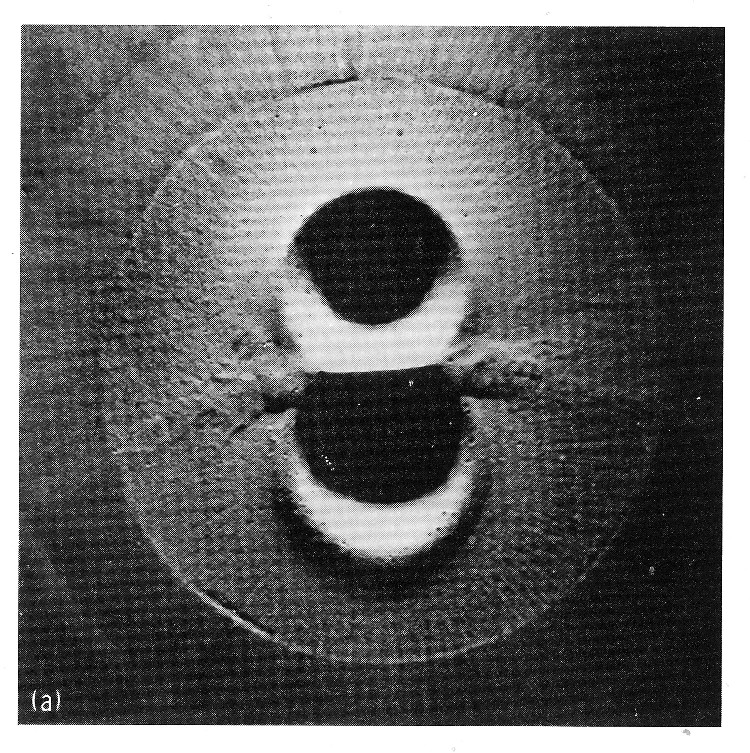
Posted
-
 by
Kitharode
moderator
by
Kitharode
moderator
That's a great find wassock. Thanks for posting. I've never seen anything like this on the Moon, but I'll see if I can find one. Any idea of the size of these craters?
Posted
-
 by
wassock
moderator
by
wassock
moderator
This may be the same thing from HiRise, not looked too close. Each crater is around a kilometer across!
Posted
-
 by
Kitharode
moderator
by
Kitharode
moderator
Can't find anything on the Moon that's even close to these martian double's. Here's another classic. http://images.nationalgeographic.com/wpf/media-live/photos/000/305/cache/mars-odyssey-dual-crater_30567_600x450.jpg
Posted
-
 by
wassock
moderator
by
wassock
moderator
These are even bigger. http://hirise-pds.lpl.arizona.edu/PDS/EXTRAS/RDR/ESP/ORB_028600_028699/ESP_028631_1965/ESP_028631_1965_RED.abrowse.jpg
I had a quick Google for similar on the moon best I could find are some fairly indistinct hourglasses postulated as possible doubles. If it is the case that there are none on the moon, why so?
Posted
-
 by
Kitharode
moderator
by
Kitharode
moderator
Ditto with the hourglasses on the Moon. The zooniverse crater project discussions also seem to suggest that 'true' doubles have not yet been found on the Moon. Your question as to why this might be is a good one. Gonna have to think about that.
Whole new ballgame with these critters - fascinating indeed. Another good find.
Posted
-
 by
jules
by
jules
Interesting! Thanks for the heads up wassock. I've highlighted this over on Moon Zoo now to see if we can find anything similar. Somehow I doubt it as it may well be down to the differences in the two bodies - geology, atmosphere, history etc - affecting the crater formation process. I'm sure a scientist will soon let us know one way or the other. But we'll see! Nothing like a bit of cross project collaboration to get the juices flowing! 😉
Posted
-
 by
wassock
moderator
by
wassock
moderator
And then there were 3 http://hirise-pds.lpl.arizona.edu/PDS/EXTRAS/RDR/ESP/ORB_020900_020999/ESP_020924_1455/ESP_020924_1455_RED.abrowse.jpg
And theres more than one of these too http://d1jqu7g1y74ds1.cloudfront.net/wp-content/uploads/2008/05/themis-mars-crater-2.jpg
In the 2nd image there's what looks like a double at the top, but it's missing the characteristic mid line ejecta seen in the lab test and it looks like there's stuff from the big one inside the small one so maybe not simultaneous?
Posted
-
 by
wassock
moderator
by
wassock
moderator
One of the theories for these I've found is that they are formed by, in my words, dog bone shaped lumps of rock - 2 blobs connected by a thinner bridge. The connection breaks under the effects of atmosphere when the thing is near the ground giving 2 impacts (or 3). If this one works then it may explain the apparent absence of these on the Moon - no atmosphere so they don't break up.
Posted
-
 by
jules
in response to wassock's comment.
by
jules
in response to wassock's comment.
We are finding more (better) examples but the ejecta is elusive. It's not easy to get wide views under different illumination - that's if we can find a suitable incidence angle in the first place. Stay tuned. 😃
Wassock, I noticed that the lab experiment you posted a picture of is from LROC - would you remember how you found it? It might just give us some clues.
Posted
-
 by
wassock
moderator
in response to jules's comment.
by
wassock
moderator
in response to jules's comment.
Jules sorry have spent some time looking but can't find it. I was just Googling stuff and it came up on the same page as one of the crater images. Twas the similarity between the two that caught my attention. Was on a tablet and the browser history tends not to be comprehensive. Think someone had puuled images together so don't think it was on the. LROCr site
Posted
-
 by
mschwamb
scientist, translator
by
mschwamb
scientist, translator
Reminds me of the snowman on Vesta . There's a really nice blog by Emily Lakdawalla about it's likely formation and on double craters in general.
Cheers,
~Meg
Posted
-
 by
wassock
moderator
by
wassock
moderator
The image of the lab test came from here:
http://www.lroc.asu.edu/news/index.php?/archives/597-Tres-Amicis.html
the moon craters pictured here are, for me, not the same, but I think they've come up with one or 2 moon candidates over at MoonZoo which may fit the profile
Posted
-
 by
jules
in response to wassock's comment.
by
jules
in response to wassock's comment.
(sigh) That's only the link I used in one of my MZ examples! Thanks for looking though wassock! Good job one of us is awake.
And given that it is referenced in a LROC article it implies that there may well be more lunar examples. Curious they highlight the septum and don't mention the distinctive ejecta pattern.
Thanks for the blog link Meg! I'd better go update Moon Zoo.
Posted
-
 by
wassock
moderator
by
wassock
moderator
The three craters in here look to my untrained eye to be more akin to gouges than craters first and last ones seem shallower at top and bottom than they are in the middle and the centre one is also shallower at the bottom end:
Could this have been made by one object coming in very shallow and bouncing or rolling? If so might there be a big lump of it somewhere down range?
How shallow an approach/big/fast would be needed for something to hit the surface and bounce off back into space (just out of interest)?
Posted
-
 by
Kitharode
moderator
by
Kitharode
moderator
Lots of evidence on the Moon for bouncing/skidding impacts. Can't see why similar events couldn't happen on Mars. Your image is certainly suggestive of skid/bounce but I'm not gonna say either way yet. They look quite filled in to me - old?
Bounce back into space - great question. No idea at all, but I might throw it at my astro-friends and see if they come up with any ideas.
Posted
-
 by
wassock
moderator
by
wassock
moderator
Seems some of the links from earlier in this thread have vanished, will see if I can drop box the images and repost the links.
just found this one which has the characteristic ejecta from the 'waistline' showing that both craters were formed at the same time. Taken fromHiView so the shaded box has the dimensions given. The original images come from here: http://www.uahirise.org/PSP_010580_2115
Posted
-
 by
wassock
moderator
by
wassock
moderator
And without the shading, all 3 craters here look very similar so this may actually be a triple impact
The next image is from a lab test of 2 objects hitting simultaneously

Experimental double simultaneous impact crater in the Ames Vertical Gun, from Oberbeck et al. (1972) Apollo 16 Preliminary Science Report.
Posted
-
 by
wassock
moderator
by
wassock
moderator
And this is from the same HiRise image, up and right from the first. This shows 2 (much older) double impacts - distinguised by the straight ridge between the 2 craters. The double crater on the right was formed by 2 different impacts, the 2nd smaller one leaving a curved ridge between the 2.
So back to the original question: Why are there "lots" of these on Mars and seemingly none on the moon?
Posted
-
 by
Kitharode
moderator
by
Kitharode
moderator
Why are there more double craters on Mars, compared to the Moon? I have absolutely no idea. However, there are a few items that might be worth consideration. The nearside of the Moon has many 'seas' (Maria) formed by ancient volcanic lava flows which might have covered over old craters, including doubles.
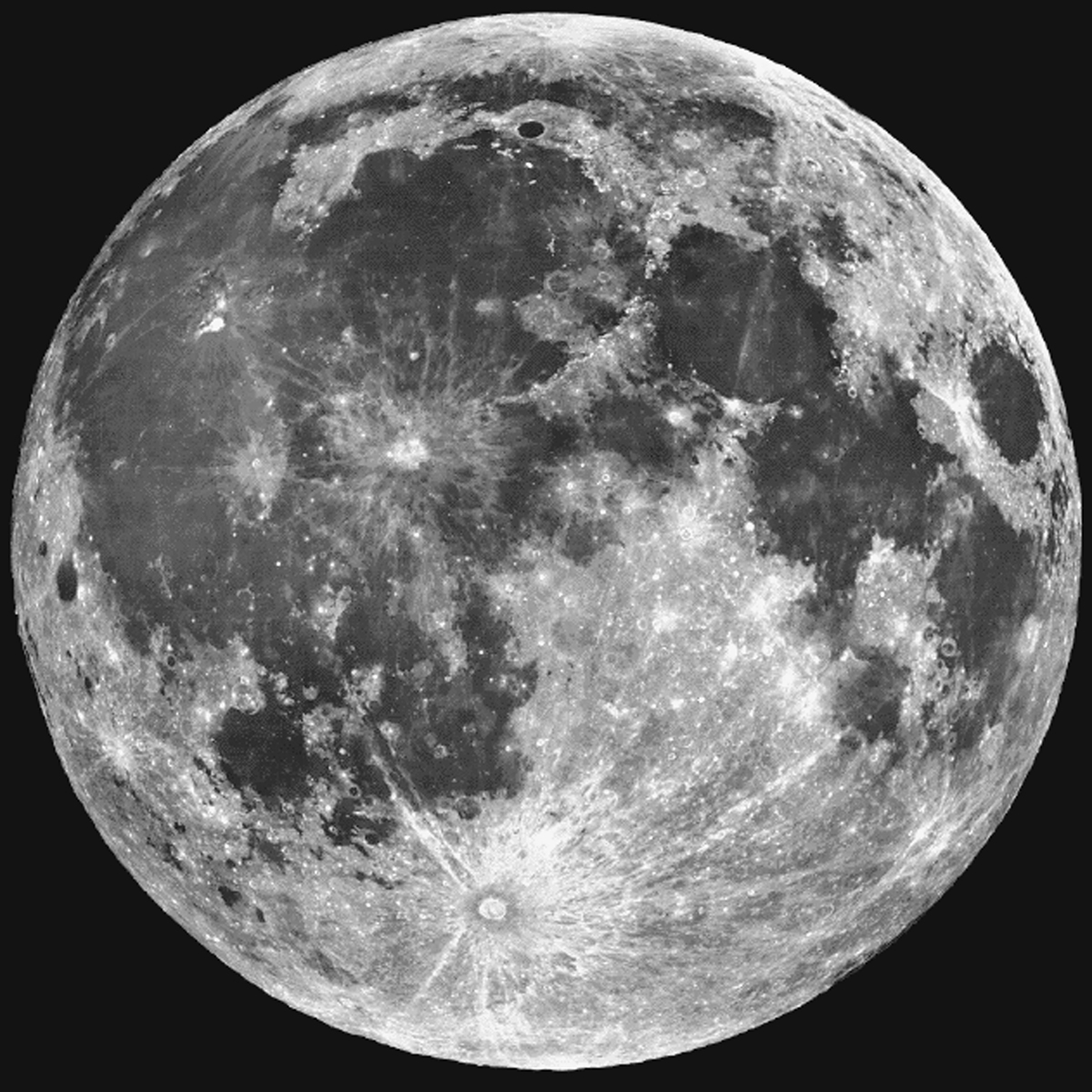
The farside of the Moon is very heavily cratered, layer upon layer, which again may have obliterated any doubles.

In relative terms, Mars is much closer to the asteroid belt than the Earth and Moon, so perhaps double asteroids drifting towards the Sun have an increased chance of colliding with Mars first.``

Other than that, I'm as stumped as you are !! 😃
Posted
-
 by
Kitharode
moderator
by
Kitharode
moderator
PS to the above: The 'Greek' and 'Trojan' asteroids cluster around the Lagrange points L4 and L5. The following diagram is for the Earth, but it applies to all the planets in the solar system. For a more detailed explanation go here: http://math.ucr.edu/home/baez/lagrange.html
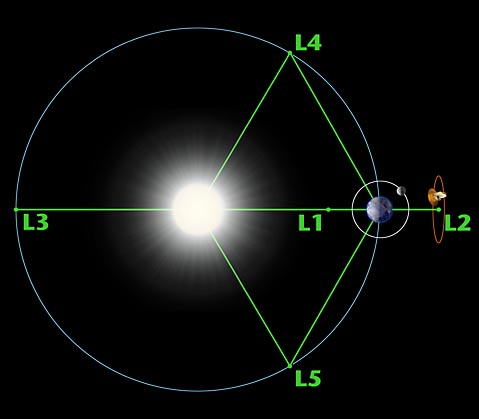
There are gaps in the asteroid belt (Kirkwood Gaps) due to 'resonance' between the belt and Jupiter. (AU = Astronomical Unit = Sun-Earth distance = ~93 million miles)

In short, the asteroid belt is a very dynamic system where collisions between the asteroids coupled with the 'push and pull' of Jupiter and Mars, and the interplay between their Lagrange points, create ample opportunities for asteroids to head off on a collision course with the inner planets.
Doesn't help answer your question, but it's all good stuff eh? 😃
Posted
-
 by
p.titchin
in response to Kitharode's comment.
by
p.titchin
in response to Kitharode's comment.
???too deep for me, though the time I have spent on the 'asteroid zoo' sight , and the number of near earth objects found makes me think. One would think that the less atmosphere an object has, the more 'rocks' would get through to result in craters. So, no surprise in recent astronomical times that the moon appears to have more craters than the earth. So--------?? Mars has less atmosphere than earth, but more than our moon. BUT Mars has no gravity warping big moon so--- this means Mars will 'cop' any 'rocks' in it's bit of space where it's gravity well has the main influence! Add to this the solar system gravity map as a whole, and the stray rocks in it, -- and-- the 'weather on the earth and Mars obscures the evidence of strikes over the millennia whereas the moon shows crystal clear impacts for those millennia ,---and-- I rest my case!!Too deep for me!! Go for it Kith. 😃
Posted
-
 by
wassock
moderator
by
wassock
moderator
Asteroid zoo is fun though 😃
There is atmosphere on mars and in the past there was more, but even a thin atmosphere leads to weathering which will hide things away, and theres I think 3 different surfaces on msrs plus of course the polar levels which cover up a lot of real estate so I dont buy the ones on the moon have been more covered up angle. My take on it is that it is all down to atmosphere. Theory being that the multiple craters are from larger objects which break up close to the surface. With the moon the first thing our lump of rock knows about the moon is "splat", whereas coming to a atmosphere it will heat up/vibrate which makes it fracture. Thus no breakups coming into the moon more when some atmosphere is encountered.
If sll this scans it maybe that theres a a critical amount of atmosphere needed to cause brwak ups, if so dating the multiple craters may be telling us what the atmosphere was like at the time?Posted
-
 by
mschwamb
scientist, translator
in response to p.titchin's comment.
by
mschwamb
scientist, translator
in response to p.titchin's comment.
Good points Pete, also the earth has weathering of rocks with the water cycle and wind erosion that doesn't happen on the Moon, some of this does happen on Mars as well, so some craters can be removed from these surfaces over time compared to the Moon (ignoring the Mare). Also forgot to mention the Earth still has volcanism so that's a factor as well in renewing the surface and deleting craters.
Cheers,
~Meg
Posted
-
 by
mschwamb
scientist, translator
in response to p.titchin's comment.
by
mschwamb
scientist, translator
in response to p.titchin's comment.
Hi,
This might be informative to the discussion
Cheers,
~Meg
Posted
-
 by
wassock
moderator
in response to mschwamb's comment.
by
wassock
moderator
in response to mschwamb's comment.
meg, think you put a space before the "http" so the link doesn't quite work, good stuff when you get there though. When I first put this up I asked the peeps at Moon Zoo if they saw similar craters there - they didn't so I'm taking it as a truth that these don't occur on the moon. I'm also working on the basis that you need a fairly thin atmosphere to make this work, lots of air and they'll break up high up and come down widely separated, to get these craters they need to hit with no more than their "impact diameter" (size of the crater they make) between them so it needs to be a close to surface break up.
it could of course be that there are (were) lots of binary asteroids floating about orbiting one another, but if this were the case we should see the effect on the moon, whereas on Mars the atmosphere will affect each differently and separate them.Posted
-
 by
wassock
moderator
by
wassock
moderator
Sorry all forgot to add the link to where these last lot of images come from, its actually quite close to the rolling boulders in the off theme thread:
http://www.uahirise.org/PSP_010580_2115
Having had another look there are upwards of a dozen candidates for double craters in this one HiRise image, and some interesting cracks top right which look like a landslide waiting to happen
Posted
-
 by
wassock
moderator
by
wassock
moderator
Been playing on HiRise again, this target has some interesting stuff on it http://hirise.lpl.arizona.edu/PSP_009711_1640. The first image is the normal greyscale map aligned jpeg imag, the rest are all captures from HiView
Posted
-
 by
wassock
moderator
by
wassock
moderator
At the bottom of the image above you can see a fairly obvious double crater. This is the result of 2 separate impacts, note the curved ridge between the 2 which shows that the one on the right came after the other.
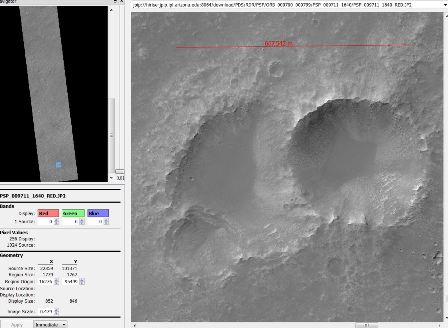
Posted
-
 by
wassock
moderator
by
wassock
moderator
But below and right of the large pair above thers a cluster of smaller craters, the double one here has a straight ridge between the 2 which indicates that both craters were created at the same time and the equatorial ejecta are also justabout visible

Posted
-
 by
wassock
moderator
by
wassock
moderator
Here are another couple of simultaneous (ses me) from the same larger image - I've just cropped to the crater for the 2nd these are fairly old and have started to be infilled
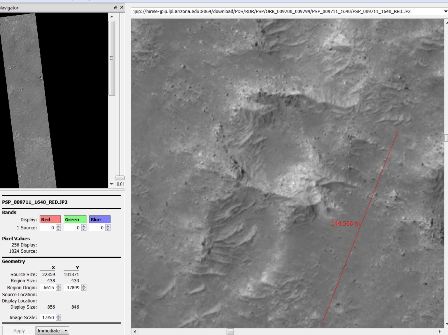
Posted
-
 by
wassock
moderator
by
wassock
moderator
There are also a couple of fairly fresh simgle impact craters on there, this one of which has a rather splendid 'splat' of ejecta
Posted
-
 by
wassock
moderator
by
wassock
moderator
And the to the days prize exhibit - a "freshish" simultaneous impact double crater, note the rays of ejecta from either side of the central ridge
Posted
-
 by
Kitharode
moderator
by
Kitharode
moderator
WOW. That's really interesting stuff wassock. You're definately 'in the zone' right now. There is certainly a lot of mystery here and some difficult questions being asked: None of which I can answer.
But I'll add what I can, when I can.
Posted
-
 by
mschwamb
scientist, translator
by
mschwamb
scientist, translator
Hiya,
Nice finds. Can you please post the HiRISE ids. Thanks in advance. There might be someone on the HiRISE team that we've contacted who could possibly be interested in these (no promises something will come from it, but we'll see). We've forwarded this thread along.
The PI of the HiRISE camera, Alfred McEwen had this to say in the email discussion 'I don't think these are common on the Moon. Small bolides break up in the martian atmosphere to create tight cluttered impacts. ' So that likely explains the reason for not seeing any or many on the Moon but finding more of these on Mars.
Cheers,
~Meg
Posted
-
 by
wassock
moderator
by
wassock
moderator
Hi, the HiRise refs are all there, the last collection are all from http://hirise.lpl.arizona.edu/PSP_009711_1640, some have the specific url as part of the screen shot
This'll be a cluster then? - from PSP_009286_1805_RED.JP2
Posted
-
 by
p.titchin
in response to wassock's comment.
by
p.titchin
in response to wassock's comment.
Great cluster.I put a tentative thought out on P4 on the Mars cratering about 18 months ago, on the difference the atmosphere made to 'incomings, but can.t find it. I was looking at the difference the atmosphere would make to 'rolling boulders' at the time as against the moon rollers! It occurred to me that with no atmosphere, the moon would take 'direct hits' rather than the incoming objects burning up or breaking up, as on earth,and to a lesser extent on Mars, and so I expected to see 'cluster' hits, but hadn't thought about 'double craters' but dropped the thoughts as we only had the south polar ice cap to look at, and craters were not readily available for study. Coincident that you have also put up the great Mars boulder pics as well. They provide more thoughts! Atmospheric braking, differing gravity, weather erosion of tracks, height of the start of the roll, slope angle, particle size of the underlying regolith affecting both the slope angle required to start a roll (?gravity involved as well?), and the friction effect in braking thereafter! etc, etc! 😉 ~Pete.
Posted
-
 by
wassock
moderator
by
wassock
moderator
Pete most of the boulders tend to be associated with crags or rocky outcrops and often on what I visualise as some sort of scree slope.
Most of thd doubles I am finding are in the 50 meter range, old and new. There are some huge ones, see the 'way off theme' thread. Cant help feel though that to get a double it has to break up near surface, which means thst for a given rock the atmosphere has to be just the right thickness. Its also interesting how often the two craters are the same size, although it could be that twins makes the signature shape that I look for better than an uneven pair. Quite a few twin craters about too, close together looking identical which I' m viewing as things that broke up just a bit higher
Posted
-
 by
mschwamb
scientist, translator
by
mschwamb
scientist, translator
Hiya
I saw this today on Twitter and thought of this tread.
Cheers,
~Meg
Posted
-
 by
wassock
moderator
by
wassock
moderator
Thanks Meg, the hirise page for this imagehttp://hirise.lpl.arizona.edu/ESP_039147_1940 only has a partial image of the crater. Fo you know where the one in your link comes from?
My perception is that the theory proposed in the link and on the hirise sitenis flawed. If this crater were caused by a binary asteroid then such things must be fairly common. There are lots of them on Mars. If they are common then dome of them ought to bump into the Moon now and again. But there don't appear to be any of these on the moon. Hence unless theres some reason that binary asteroids cant get to the moon, of there are in fact some on the moon
then binary asteroids are not causing these craters. NB they sre pretty easy to find on Mars ant not on the moon. See sbove for reasons ehy this could be the casePosted
-
 by
mschwamb
scientist, translator
in response to wassock's comment.
by
mschwamb
scientist, translator
in response to wassock's comment.
In this case to get three you need likely one to be a satellite since one's significantly smaller I think that's the thinking. Binaries are not so uncommon in the asteroid belt, they've been found in observations. The Near Earth Asteroid that just came close to the Earth has a satellite for example. The reasoning from the HiRISE PI about double craters is the atmosphere. It breaks stuff up as it comes up from the heating the object goes through as it enters the atmosphere, so more chance for stuff to break up into larger chunks as it burns up in the atmosphere.. Hence why more double craters are found on Mars versus Moon.
I read it as a hypothesis that they think it's actually binary by the fact there are 3 craters supported by the ejecta pattern has impacting at the same time on top of each other. Since double craters are common and you might argue those are apparently easy to produce by breakup you might agree to get three might require a moon.
Other argument they're using is size. the two large craters are pretty much even and we know of equal size binaries exist in the Kuiper belt and asteroid belt, but as you said it may not be a triple or double could be large guy that broke up.
Cheers,
~Meg
Posted
-
 by
wassock
moderator
by
wassock
moderator
Far as I can see most of the binaries identified are fairly big as would be expected, and there seems to be a idea that most of them are nt solids but more piles of rocks, whic would break apart when they encounter atmosphere. Much of what I'm seeing is craters in the 50 to 200 meters scale or smaller.
Either way up we need to end up with 2 lumps which hit within their impact diameter (size of the crater) of oneanother. So if we pretend for a moment that the resultant crater is 20 times the size of the impactor, then for a pair of 100 meter craters we need two 5 meter lumps to land around 90 meters apart. So thats a mutual orbit distance of about 18 times the size of each. The stuff I've seen seems to have the observed binaries much closer than that relative to their size. So fir the binaries idea to work for me there woukd have to be sone sort of golden ratio of size to orbit distance coupled with the effect of the Martian atnosphere, which is just right to allow both bits to hit at just the right distance apart, simultaneously (as in at exactly the same time).
Could be that the effect of atmosphere is to pull them apart but my feeling, based on no science at all, is that the effect on two irregular rotating bodies hitting atmosphere would be pull them well away from each other.
From my limited observations triples are not uncommon, specially of the 2 sort of equals and a smaller one variety. But I find the idea that 2 large bodies accompanied by a third smaller one would stay as a compact group, after hitting atmosphere, difficult. Seem to be plenty of asymetric doubles too.
However it seems fairly easy to imagine 67P/Churyumov–Gerasimenko. Coming in, breaking into 2 and hitting as 2 close impacts. Ok thats a comet not an asteroid, but you get the picture.
AND if binaries are the cause we should be seeing lots of these on the moon.
Posted
-
 by
wassock
moderator
by
wassock
moderator
Near triple
Triple
quad ?
Posted